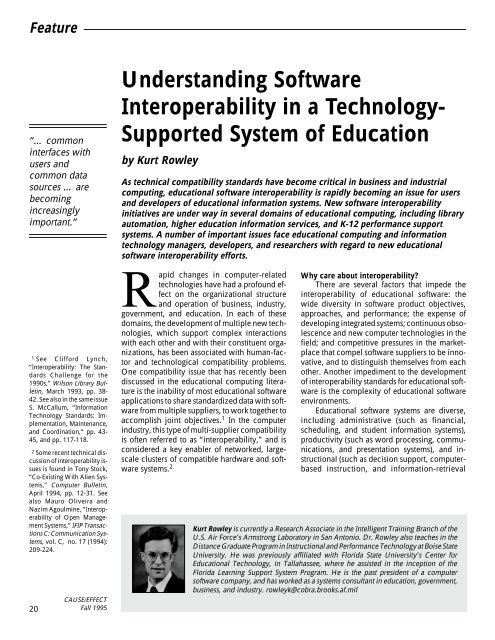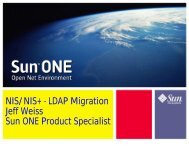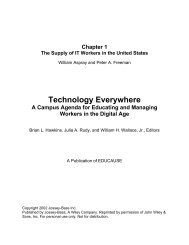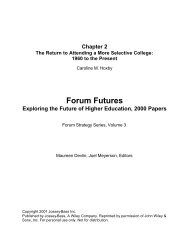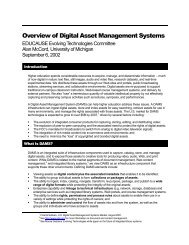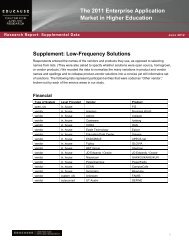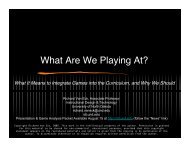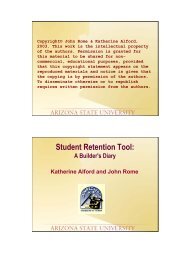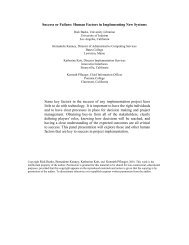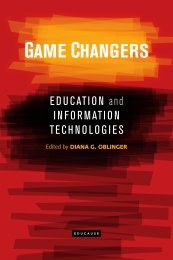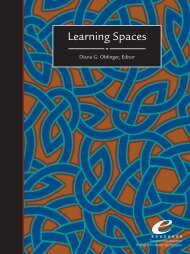Understanding Software Interoperability in a Technology ... - Educause
Understanding Software Interoperability in a Technology ... - Educause
Understanding Software Interoperability in a Technology ... - Educause
You also want an ePaper? Increase the reach of your titles
YUMPU automatically turns print PDFs into web optimized ePapers that Google loves.
Feature<br />
“… common<br />
<strong>in</strong>terfaces with<br />
users and<br />
common data<br />
sources … are<br />
becom<strong>in</strong>g<br />
<strong>in</strong>creas<strong>in</strong>gly<br />
important.”<br />
1 See Clifford Lynch,<br />
“<strong>Interoperability</strong>: The Standards<br />
Challenge for the<br />
1990s,” Wilson Library Bullet<strong>in</strong>,<br />
March 1993, pp. 38-<br />
42. See also <strong>in</strong> the same issue<br />
S. McCallum, “Information<br />
<strong>Technology</strong> Standards: Implementation,<br />
Ma<strong>in</strong>tenance,<br />
and Coord<strong>in</strong>ation,“ pp. 43-<br />
45, and pp. 117-118.<br />
2 Some recent technical discussion<br />
of <strong>in</strong>teroperability issues<br />
is found <strong>in</strong> Tony Stock,<br />
“Co-Exist<strong>in</strong>g With Alien Systems,”<br />
Computer Bullet<strong>in</strong>,<br />
April 1994, pp. 12-31. See<br />
also Mauro Oliveira and<br />
Nazim Agoulm<strong>in</strong>e, “<strong>Interoperability</strong><br />
of Open Management<br />
Systems,” IFIP Transactions<br />
C: Communication Systems,<br />
vol. C, no. 17 (1994):<br />
209-224.<br />
20<br />
CAUSE/EFFECT<br />
Fall 1995<br />
<strong>Understand<strong>in</strong>g</strong> <strong>Software</strong><br />
<strong>Interoperability</strong> <strong>in</strong> a <strong>Technology</strong>-<br />
Supported System of Education<br />
by Kurt Rowley<br />
As technical compatibility standards have become critical <strong>in</strong> bus<strong>in</strong>ess and <strong>in</strong>dustrial<br />
comput<strong>in</strong>g, educational software <strong>in</strong>teroperability is rapidly becom<strong>in</strong>g an issue for users<br />
and developers of educational <strong>in</strong>formation systems. New software <strong>in</strong>teroperability<br />
<strong>in</strong>itiatives are under way <strong>in</strong> several doma<strong>in</strong>s of educational comput<strong>in</strong>g, <strong>in</strong>clud<strong>in</strong>g library<br />
automation, higher education <strong>in</strong>formation services, and K-12 performance support<br />
systems. A number of important issues face educational comput<strong>in</strong>g and <strong>in</strong>formation<br />
technology managers, developers, and researchers with regard to new educational<br />
software <strong>in</strong>teroperability efforts.<br />
Rapid changes <strong>in</strong> computer-related<br />
technologies have had a profound effect<br />
on the organizational structure<br />
and operation of bus<strong>in</strong>ess, <strong>in</strong>dustry,<br />
government, and education. In each of these<br />
doma<strong>in</strong>s, the development of multiple new technologies,<br />
which support complex <strong>in</strong>teractions<br />
with each other and with their constituent organizations,<br />
has been associated with human-factor<br />
and technological compatibility problems.<br />
One compatibility issue that has recently been<br />
discussed <strong>in</strong> the educational comput<strong>in</strong>g literature<br />
is the <strong>in</strong>ability of most educational software<br />
applications to share standardized data with software<br />
from multiple suppliers, to work together to<br />
accomplish jo<strong>in</strong>t objectives. 1 In the computer<br />
<strong>in</strong>dustry, this type of multi-supplier compatibility<br />
is often referred to as “<strong>in</strong>teroperability,” and is<br />
considered a key enabler of networked, largescale<br />
clusters of compatible hardware and software<br />
systems. 2<br />
Why care about <strong>in</strong>teroperability?<br />
There are several factors that impede the<br />
<strong>in</strong>teroperability of educational software: the<br />
wide diversity <strong>in</strong> software product objectives,<br />
approaches, and performance; the expense of<br />
develop<strong>in</strong>g <strong>in</strong>tegrated systems; cont<strong>in</strong>uous obsolescence<br />
and new computer technologies <strong>in</strong> the<br />
field; and competitive pressures <strong>in</strong> the marketplace<br />
that compel software suppliers to be <strong>in</strong>novative,<br />
and to dist<strong>in</strong>guish themselves from each<br />
other. Another impediment to the development<br />
of <strong>in</strong>teroperability standards for educational software<br />
is the complexity of educational software<br />
environments.<br />
Educational software systems are diverse,<br />
<strong>in</strong>clud<strong>in</strong>g adm<strong>in</strong>istrative (such as f<strong>in</strong>ancial,<br />
schedul<strong>in</strong>g, and student <strong>in</strong>formation systems),<br />
productivity (such as word process<strong>in</strong>g, communications,<br />
and presentation systems), and <strong>in</strong>structional<br />
(such as decision support, computerbased<br />
<strong>in</strong>struction, and <strong>in</strong>formation-retrieval<br />
Kurt Rowley is currently a Research Associate <strong>in</strong> the Intelligent Tra<strong>in</strong><strong>in</strong>g Branch of the<br />
U.S. Air Force’s Armstrong Laboratory <strong>in</strong> San Antonio. Dr. Rowley also teaches <strong>in</strong> the<br />
Distance Graduate Program <strong>in</strong> Instructional and Performance <strong>Technology</strong> at Boise State<br />
University. He was previously affiliated with Florida State University’s Center for<br />
Educational <strong>Technology</strong>, <strong>in</strong> Tallahassee, where he assisted <strong>in</strong> the <strong>in</strong>ception of the<br />
Florida Learn<strong>in</strong>g Support System Program. He is the past president of a computer<br />
software company, and has worked as a systems consultant <strong>in</strong> education, government,<br />
bus<strong>in</strong>ess, and <strong>in</strong>dustry. rowleyk@cobra.brooks.af.mil
systems) applications. Educational software operates<br />
<strong>in</strong> many separate worlds, from K–12<br />
through higher education, each with unique databases,<br />
user-<strong>in</strong>terfaces, and <strong>in</strong> the case of <strong>in</strong>structional<br />
software, assorted electronic media.<br />
Without strong evidence of potential benefits to<br />
justify the effort of generat<strong>in</strong>g and follow<strong>in</strong>g<br />
standards of <strong>in</strong>teroperability for educational software,<br />
both the developers and the users of educational<br />
software might avoid the issue, and as a<br />
result, miss out on the opportunity to benefit from<br />
mean<strong>in</strong>gful, future-th<strong>in</strong>k<strong>in</strong>g, standards of <strong>in</strong>teroperability.<br />
3<br />
Standardization of educational electronic<br />
data communication, media formats, and eventually<br />
software applications, is under way with<strong>in</strong><br />
the educational comput<strong>in</strong>g <strong>in</strong>dustry, often driven<br />
by various user organizations and educational<br />
<strong>in</strong>itiatives. Such standardization could eventually<br />
<strong>in</strong>clude the development of access to universal<br />
student records or performance data, <strong>in</strong>formation<br />
that may be useful at all levels of a person’s<br />
education, and throughout a career. Although<br />
diverse applications cont<strong>in</strong>ue to coexist <strong>in</strong> education,<br />
common <strong>in</strong>terfaces with users and common<br />
data sources, created through the def<strong>in</strong>ition<br />
and development of standards of <strong>in</strong>teroperability,<br />
are becom<strong>in</strong>g <strong>in</strong>creas<strong>in</strong>gly important.<br />
The success of educational <strong>in</strong>teroperability<br />
standards will be particularly important if off-theshelf<br />
<strong>in</strong>structional software, productivity software,<br />
adm<strong>in</strong>istrative software, and even off-theshelf<br />
“eduta<strong>in</strong>ment” software is to be successfully<br />
<strong>in</strong>tegrated with traditional educational systems,<br />
and with new distance learn<strong>in</strong>g networks, at the<br />
application level. Without <strong>in</strong>teroperability, there<br />
will be no universal way to electronically manage<br />
and track the results of student usage of<br />
<strong>in</strong>creas<strong>in</strong>gly popular and available <strong>in</strong>structional<br />
software. By provid<strong>in</strong>g systemwide access to all<br />
electronic educational system data, <strong>in</strong>teroperability<br />
<strong>in</strong> educational software has the capacity to<br />
electronically improve the focus of all components<br />
of education on the missions of the organization.<br />
Case experience and anecdotal evidence <strong>in</strong><br />
multiple electronic standards development <strong>in</strong>itiatives<br />
both with<strong>in</strong> and outside the field of education<br />
suggest that a strong argument for<br />
<strong>in</strong>teroperability can be made. However, these<br />
evidences also raise a range of issues for educational<br />
comput<strong>in</strong>g managers, developers, and researchers.<br />
These issues must be understood if<br />
standards of <strong>in</strong>teroperability are to be discussed<br />
and justified, and if users are to benefit from<br />
<strong>in</strong>teroperable educational software systems<br />
through better achievement of educational missions.<br />
New technologies and <strong>in</strong>teroperability<br />
To address the role of <strong>in</strong>teroperability, one<br />
should consider first the difficulty of <strong>in</strong>tegrat<strong>in</strong>g<br />
new educational technologies <strong>in</strong>to practice.<br />
Consider <strong>in</strong>structional software, for example. In<br />
most schools today, <strong>in</strong>structional software is used<br />
as a reward or a diversion, with little <strong>in</strong>tegration<br />
<strong>in</strong>to the curriculum, 4 although the use of productivity<br />
tools such as word processors has been<br />
widely accepted <strong>in</strong> schools at all levels. The<br />
<strong>in</strong>tegration of more powerful <strong>in</strong>structional<br />
tools—such as computer-based <strong>in</strong>struction and<br />
micro-world simulations—<strong>in</strong>to the average<br />
classroom has been slow and difficult. 5<br />
One reason often given for the lack of <strong>in</strong>tegration<br />
of computers <strong>in</strong>to the ma<strong>in</strong>stream of<br />
education is resistance to the use of technology<br />
by <strong>in</strong>structors. 6 Bus<strong>in</strong>ess and <strong>in</strong>dustry also experienced<br />
front-l<strong>in</strong>e resistance to the use of new<br />
technologies <strong>in</strong> the early years of automation, but<br />
through a cont<strong>in</strong>ual dialogue between users and<br />
developers, the new technologies were successfully<br />
<strong>in</strong>tegrated with the front l<strong>in</strong>es. One of the<br />
major accomplishments of this dialogue, and a<br />
key factor <strong>in</strong> the acceptance and <strong>in</strong>tegration of<br />
computer technologies <strong>in</strong> bus<strong>in</strong>ess, was their<br />
sett<strong>in</strong>g of, and follow<strong>in</strong>g, standards of software<br />
and hardware compatibility between compet<strong>in</strong>g<br />
commercial suppliers, a comb<strong>in</strong>ed hardware<br />
and software <strong>in</strong>teroperability. As <strong>in</strong>teroperability<br />
becomes a broader issue <strong>in</strong> educational comput<strong>in</strong>g<br />
at all levels, it is useful to consider examples<br />
of how <strong>in</strong>teroperability has succeeded.<br />
The Internet example<br />
A successful example of <strong>in</strong>teroperability is<br />
evidenced <strong>in</strong> the work<strong>in</strong>gs of the components of<br />
the Internet. In this case, software from multiple<br />
suppliers cooperates to manage a multitude of<br />
electronic networks, each connected to a common<br />
electronic backbone. While each of the<br />
software systems <strong>in</strong>volved <strong>in</strong> a s<strong>in</strong>gle Internet<br />
transaction may be supported by different hardware<br />
platforms and telecommunication software<br />
suppliers, by follow<strong>in</strong>g standardized protocols,<br />
each transaction proceeds <strong>in</strong> a reliable fashion,<br />
handed-off across the various networks. The benefits<br />
of <strong>in</strong>teroperability to the Internet are significant.<br />
The <strong>in</strong>teroperability among the components<br />
of the Internet enable the creation of an<br />
enormous telecommunications <strong>in</strong>frastructure,<br />
facilitat<strong>in</strong>g the proliferation of global-area applications<br />
such as ftp and the World Wide Web.<br />
The MIDI example<br />
Another example of deliberately developed<br />
standards of <strong>in</strong>teroperability is the musical <strong>in</strong>strument<br />
digital <strong>in</strong>terface (MIDI) standard. 7 MIDI, an<br />
3 A good discussion of standards<br />
of <strong>in</strong>teroperability is<br />
found <strong>in</strong> Lynch, op cit.<br />
4 An example of the lack of<br />
<strong>in</strong>tegration of computerbased<br />
<strong>in</strong>struction <strong>in</strong>to the<br />
curriculum has been given<br />
by Poppy L. Pruett, “Utilization<br />
of the Microcomputer <strong>in</strong><br />
the Mathematics Classroom,”<br />
Computers <strong>in</strong> Human<br />
Behavior 9, no. 1<br />
(1993): 17-26.<br />
5 For discussion of the problems<br />
of <strong>in</strong>tegration of technology<br />
<strong>in</strong>to education, see<br />
Henry Becker, “How Computers<br />
Are Used <strong>in</strong> United<br />
States Schools: Basic Data<br />
from the 1989 I.E.A. Computers<br />
<strong>in</strong> Education Survey,”<br />
Journal of Educational Comput<strong>in</strong>g<br />
Research 7, no. 4<br />
(1991): 385-406. See also<br />
Tjeerd Plomp and Jef<br />
Moonen (eds.), “Implementation<br />
of Computers <strong>in</strong> Education,”<br />
International Journal<br />
of Educational Research<br />
17, no. 1 (1991): 1-121 (a<br />
special issue with n<strong>in</strong>e papers<br />
on the use and <strong>in</strong>tegration<br />
of computers <strong>in</strong> education).<br />
6 Resistance to technology<br />
by <strong>in</strong>structors is discussed by<br />
Robert Hannaf<strong>in</strong> and Wilhelm<strong>in</strong>a<br />
Savenye, “<strong>Technology</strong><br />
<strong>in</strong> the Classroom: The<br />
Teacher’s New Role and Resistance<br />
to It,” Educational<br />
<strong>Technology</strong> 33, no. 6 (1993):<br />
26-31.<br />
CAUSE/EFFECT<br />
Fall 1995 21
“… most<br />
educational<br />
software<br />
applications have<br />
no ability to share<br />
data …”<br />
7 For a discussion of us<strong>in</strong>g<br />
the MIDI standard, see Mark<br />
Ely, “<strong>Software</strong> for Classroom<br />
Music Mak<strong>in</strong>g,” Music Educators<br />
Journal 78, no. 8<br />
(1992): 41-43.<br />
8 The fields of communication<br />
and education have<br />
both benefitted from the success<br />
of MIDI. See, for example,<br />
Gregory Jordahl,<br />
“Teach<strong>in</strong>g Music <strong>in</strong> the Age<br />
of MIDI,” Classroom Computer<br />
Learn<strong>in</strong>g 9, no. 2<br />
(1988): 78-85. See also Brian<br />
Moore, “Music, <strong>Technology</strong>,<br />
and an Evolv<strong>in</strong>g Curriculum,”<br />
NASSP Bullet<strong>in</strong><br />
76, no. 544 (1992): 42-46.<br />
9 See Judith Molka, “Surrounded<br />
by Standards, There<br />
Is a Simpler View,” Journal of<br />
the American Society for Information<br />
Science 43, no. 8<br />
(1992): 526-530.<br />
10 For a discussion of<br />
SPEEDE, see B. H. Palmer<br />
and P. Betty Wei, “SPEEDE<br />
Made Easy,” College & University,<br />
Fall 1993, pp. 4-13;<br />
and E. W. Carson, “Electronic<br />
Transcripts—EDI <strong>in</strong><br />
Academic Adm<strong>in</strong>istration,”<br />
CAUSE/EFFECT, W<strong>in</strong>ter,<br />
1991, pp. 3-7,15.<br />
22<br />
CAUSE/EFFECT<br />
Fall 1995<br />
electronic network standard common <strong>in</strong> home,<br />
school, and professional music studios, was developed<br />
by a consortium of electronic music<br />
equipment suppliers, and was designed to allow<br />
all brands of computerized electronic musical<br />
<strong>in</strong>struments to use a common network <strong>in</strong>terface<br />
at both the hardware and software levels. The<br />
high level of <strong>in</strong>teroperability among MIDI-compatible<br />
electronic music equipment has made it<br />
possible for musicians to use an electronic music<br />
keyboard from any manufacturer that supports<br />
MIDI to control any other music keyboard, or<br />
electronic musical <strong>in</strong>strument with a MIDI <strong>in</strong>terface.<br />
The most obvious benefit of MIDI is that <strong>in</strong><br />
most music studios today, one can f<strong>in</strong>d a mix of<br />
all k<strong>in</strong>ds and brands of electronic studio equipment<br />
work<strong>in</strong>g together as components. With<br />
MIDI, musical equipment manufacturers and<br />
software suppliers specialize <strong>in</strong> their areas of<br />
expertise, yet their products work harmoniously<br />
with products from other suppliers to create a<br />
larger whole, an <strong>in</strong>tegrated, technology-supported<br />
music studio. With MIDI, electronic musical<br />
<strong>in</strong>strument manufacturers do not have to<br />
“re-<strong>in</strong>vent the wheel” of the computer network<br />
<strong>in</strong>terface between their devices.<br />
MIDI has spawned a new genre of music<br />
technology firms that specialize <strong>in</strong> software that<br />
manages the composition and performance of<br />
music across MIDI networks. The quality and<br />
sophistication of products <strong>in</strong> the electronic <strong>in</strong>strument<br />
<strong>in</strong>dustry has leaped forward over the<br />
past decade, spurred on <strong>in</strong> part by user demand<br />
for the MIDI <strong>in</strong>terface, as well as by the music and<br />
studio <strong>in</strong>dustry’s acceptance of, adherence to,<br />
and promotion of the MIDI standard. 8<br />
The challenge for education<br />
The successful <strong>in</strong>tegration of computer automation<br />
<strong>in</strong>to the front l<strong>in</strong>es of education, <strong>in</strong>clud<strong>in</strong>g,<br />
for example, the use of the computer-based<br />
<strong>in</strong>structional and microworld capabilities of<br />
computers <strong>in</strong> classrooms, requires a level of<br />
technical collaboration among educational<br />
stakeholders and participants that parallels efforts<br />
<strong>in</strong> the prior examples. The complexity of the<br />
<strong>in</strong>formation requirements of education is probably<br />
greater than the complexity of either the<br />
communication standards of the Internet, or the<br />
network standards of MIDI. The development of<br />
standards of <strong>in</strong>teroperability for educational software<br />
requires the <strong>in</strong>volvement of a menagerie of<br />
knowledge and <strong>in</strong>formation stakeholders. Education<br />
is, after all, a prodigious <strong>in</strong>formation <strong>in</strong>dustry.<br />
Def<strong>in</strong><strong>in</strong>g the standards of <strong>in</strong>teroperability<br />
In contrast to the enabl<strong>in</strong>g <strong>in</strong>formation-shar<strong>in</strong>g<br />
standards used by the Internet, and by MIDIbased<br />
equipment <strong>in</strong> music studios, most educational<br />
software applications have no ability to<br />
share data, or to contribute student performance<br />
<strong>in</strong>formation to common databases. Educational<br />
comput<strong>in</strong>g is an enterprise of many applications<br />
tied together <strong>in</strong> educational goals, but not always<br />
l<strong>in</strong>ked <strong>in</strong> a technical sense, such as with software<br />
<strong>in</strong>teroperability.<br />
The importance of formally design<strong>in</strong>g standards<br />
of <strong>in</strong>teroperability cannot be overstated.<br />
When de facto standards arise, they often take on<br />
attributes of the lowest common denom<strong>in</strong>ators of<br />
compatibility, not serv<strong>in</strong>g the future <strong>in</strong>terests of<br />
the field. 9 The development of a standard gauge<br />
for U.S. railroads is an <strong>in</strong>terest<strong>in</strong>g illustration of<br />
the resilience of de facto standards, and their<br />
resistance to improvement. If clear-th<strong>in</strong>k<strong>in</strong>g systems<br />
designers do not plan well for <strong>in</strong>teroperability<br />
standards at all levels of educational comput<strong>in</strong>g,<br />
it is probable that the standards which do<br />
<strong>in</strong> time emerge (like the railroad gauges <strong>in</strong> the<br />
sidebar illustration) will be both <strong>in</strong>ferior and<br />
difficult to displace.<br />
Because commercial educational software<br />
manufacturers are subject to competitive forces,<br />
they cannot afford to develop standards without<br />
widespread agreement. For one or two firms<br />
alone, entry <strong>in</strong>to <strong>in</strong>teroperability agreements can<br />
become a liability, if other firms attempt to outcompete<br />
their standards, or create closed standards<br />
giv<strong>in</strong>g their exist<strong>in</strong>g products competitive<br />
advantage. It is important, therefore, <strong>in</strong> any standards<br />
effort <strong>in</strong>volv<strong>in</strong>g commercial firms, to develop<br />
a consensus about long-term upwardcompatibility<br />
issues, and ma<strong>in</strong>ta<strong>in</strong> a level play<strong>in</strong>g<br />
field for all participants, <strong>in</strong>clud<strong>in</strong>g the newest<br />
players as well as the established ones. Develop<strong>in</strong>g<br />
an understand<strong>in</strong>g of theoretical and applied<br />
issues can assist <strong>in</strong> reach<strong>in</strong>g this consensus about<br />
long-term <strong>in</strong>teroperability needs. Such is the role<br />
that some system users, developers, and researchers<br />
are now seek<strong>in</strong>g to play, as issues and<br />
opportunities <strong>in</strong> <strong>in</strong>teroperability are identified.<br />
Current <strong>in</strong>teroperability efforts <strong>in</strong> education<br />
Electronic <strong>in</strong>teroperability has recently been<br />
achieved <strong>in</strong> several doma<strong>in</strong>s of educational comput<strong>in</strong>g.<br />
For example, the SPEEDE (EDI) standard<br />
has been developed <strong>in</strong> higher education for the<br />
electronic exchange of transcripts through a universal<br />
transcript def<strong>in</strong>ition. 10 Other examples<br />
with<strong>in</strong> higher education are the communication<br />
protocol standards of MARC and Z39.50 used <strong>in</strong><br />
library automation. 11 These application-level<br />
technical standards were developed <strong>in</strong> conjunc-
tion with organizations such as the International<br />
Organization for Standardization (ISO, Geneva,<br />
Switzerland), the American National Standards<br />
Institute (ANSI, New York), and the National<br />
Information Standards Organization (NISO, New<br />
Brunswick, New Jersey). Another level of standard<br />
developed recently is the Open <strong>Software</strong><br />
Foundation’s Distributed Comput<strong>in</strong>g Environment<br />
(OSF’s DCE). DCE technology will provide<br />
standards at the data access and network resource,<br />
or “middleware,” level. 12 Further new<br />
technical standards, <strong>in</strong> early stages of development,<br />
will <strong>in</strong>clude a broader range of educational<br />
software.<br />
The state of Florida, a pioneer <strong>in</strong> EDI <strong>in</strong><br />
education through the Florida Information Resources<br />
Network (FIRN) system, a statewide network<br />
for the Florida education system, is seek<strong>in</strong>g<br />
through the auspices of the Florida Schoolyear<br />
2000 <strong>in</strong>itiative 13 to extend the def<strong>in</strong>ition and<br />
utilization of standardized electronic educational<br />
<strong>in</strong>formation. This is be<strong>in</strong>g done through the<br />
creation of data flow control (DFC) standards,<br />
which new electronic learn<strong>in</strong>g support systems<br />
for Florida K–12 schools must adhere to, several<br />
of which are under development as part of<br />
Schoolyear 2000’s Florida Learn<strong>in</strong>g Support System<br />
(FLSS) program. 14 Data flow control is an<br />
open access method for data that is “owned” by<br />
multiple software systems. A data flow controller<br />
has the ability to manage the access to data from<br />
various software systems from a variety of suppliers.<br />
The Florida Learn<strong>in</strong>g Support System data<br />
flow controller (FLSS-DFC) will <strong>in</strong>teract with<br />
<strong>in</strong>teroperable applications to automatically<br />
ma<strong>in</strong>ta<strong>in</strong> and grant access to public data element<br />
dictionaries conta<strong>in</strong><strong>in</strong>g <strong>in</strong>formation such as data<br />
ownership, characteristics, locations, access<br />
privileges, and update requirements. 15<br />
The FLSS-DFC standard will <strong>in</strong>itially allow<br />
electronic learn<strong>in</strong>g support systems of all varieties,<br />
and from multiple vendors, to <strong>in</strong>teract and<br />
share data between all levels of educational<br />
systems, us<strong>in</strong>g standard protocols. Uniform data<br />
flow control will eventually extend to a host of<br />
other educational software systems, allow<strong>in</strong>g for<br />
<strong>in</strong>teroperability between and among various student<br />
<strong>in</strong>formation systems, <strong>in</strong>structional software<br />
systems, performance support systems, and adm<strong>in</strong>istrative<br />
<strong>in</strong>formation systems at all levels of<br />
education <strong>in</strong> Florida.<br />
There are a number of other recent and<br />
emerg<strong>in</strong>g standards that will facilitate the<br />
<strong>in</strong>teroperability of educational software. These<br />
<strong>in</strong>clude data communication standards as well as<br />
various standards under development <strong>in</strong> the<br />
computer <strong>in</strong>dustry for multimedia <strong>in</strong>teroperability.<br />
New multimedia standards efforts seek to<br />
The Longevity of a De Facto Standard<br />
The story of the U.S. standard railroad track gauge (the distance between<br />
the rails) is an <strong>in</strong>terest<strong>in</strong>g illustration of how de facto technical standards<br />
survive over long periods of time. The U.S. standard track gauge is 4' 8-1/2".<br />
The reason generally given for us<strong>in</strong>g this number is that the first U.S. railroads<br />
were built by English ex-patriots, and that was the gauge used <strong>in</strong> England at<br />
the time.<br />
Most railroad historians believe that the English gauge for railroads was<br />
used because early English tramways had used the same gauge. Further,<br />
historians believe that tramway rails were spaced at 4' 8-1/2" because the<br />
builders of early tramway cars used the most logical exist<strong>in</strong>g tools and axle<br />
widths available to them, namely, tools and jigs available for the construction<br />
of horse- and oxen-drawn wagons.<br />
As the story goes, wheels on wagons were generally spaced to travel<br />
securely <strong>in</strong> the ruts of the roads <strong>in</strong> Great Brita<strong>in</strong>, which had been unchanged<br />
s<strong>in</strong>ce Roman times. Wheels spaced any wider or narrower than the ruts <strong>in</strong> the<br />
road would never survive the shear<strong>in</strong>g forces of the wagon, or chariot,<br />
travel<strong>in</strong>g <strong>in</strong> and out of the ruts. Thus, the U.S. standard railroad track gauge<br />
may be attributable to the axle-width of the Roman war chariot, which was<br />
probably determ<strong>in</strong>ed by the width of the typical Roman horse.<br />
There were many attempts by <strong>in</strong>novative rail companies <strong>in</strong> the early<br />
years of railroad<strong>in</strong>g to widen the U.S. standard track gauge. The justification<br />
for the wider gauge usually given was that wider gauges lend more stability<br />
and allow higher carry<strong>in</strong>g capacity. In the mid-1800s, cities and states often<br />
built rail routes with track gauges <strong>in</strong>compatible with their economically<br />
compet<strong>in</strong>g neighbor cities and states, runn<strong>in</strong>g their own rail l<strong>in</strong>es to important<br />
agricultural, shipp<strong>in</strong>g, and <strong>in</strong>dustry centers <strong>in</strong> an attempt to secure<br />
economic development. It was common for long-distance passengers and<br />
cargo to be unloaded and reloaded many times as they were transferred<br />
between railroad carriers on tracks of different gauges. Passengers and freight<br />
customers came to expect frequent “breaks <strong>in</strong> gauge,” us<strong>in</strong>g local services for<br />
the unload<strong>in</strong>g, across-town transportation, and reload<strong>in</strong>g of the tra<strong>in</strong>s.<br />
Debate about the <strong>in</strong>efficiencies of the well-established, <strong>in</strong>compatible<br />
railroad track gauges raged for over thirty years <strong>in</strong> the U.S. * Even Abraham<br />
L<strong>in</strong>coln got <strong>in</strong>volved, attempt<strong>in</strong>g to <strong>in</strong>stitute a standardized, wide-track<br />
gauge. The idea of a s<strong>in</strong>gle track gauge standard eventually won the day, but<br />
the momentum of the narrower English standard, which by the 1860s was<br />
used on slightly more than half of the railways, was too great to ignore. In the<br />
1880s the railroads were forced by grow<strong>in</strong>g national market forces to adopt<br />
the English standard, still <strong>in</strong> use <strong>in</strong> the U.S.<br />
* The debate surround<strong>in</strong>g the <strong>in</strong>tegration of diverse, 19th Century American railroads is<br />
strik<strong>in</strong>gly similar to current standards discussions <strong>in</strong> comput<strong>in</strong>g. For a fasc<strong>in</strong>at<strong>in</strong>g treatment<br />
of this <strong>in</strong>tegration, see George Taylor and Irene Neu, The American Railroad Network 1861-<br />
1890 (Cambridge, Mass.: Harvard University Press, 1956).<br />
make multimedia file streams <strong>in</strong>teroperable by<br />
allow<strong>in</strong>g standardized multimedia data to flow<br />
across open networks for use by all compliant<br />
software applications. 16 Several <strong>in</strong>terest<strong>in</strong>g and<br />
important <strong>in</strong>teroperability standards and potential<br />
standards across the scale of educational<br />
comput<strong>in</strong>g are depicted <strong>in</strong> Exhibit I.<br />
The lead<strong>in</strong>g questions<br />
A number of new standards of <strong>in</strong>teroperability<br />
have been developed and implemented<br />
over the past few years, and more are on the<br />
horizon for education. A few questions related to<br />
11 For a discussion of these<br />
library automation standards,<br />
see the articles by<br />
Lynch and by McCallum, op<br />
cit.<br />
(footnotes cont<strong>in</strong>ued)<br />
CAUSE/EFFECT<br />
Fall 1995 23
“A fundamental<br />
and ongo<strong>in</strong>g<br />
discussion …<br />
should identify<br />
which data<br />
elements are most<br />
important to be<br />
shared among<br />
systems of<br />
educational<br />
software.”<br />
12 A good discussion of DCE<br />
can be found <strong>in</strong> “Why Your<br />
Campus Should Consider<br />
Adopt<strong>in</strong>g OSF’s DCE Standards,”<br />
by Samuel Plice,<br />
CAUSE/EFFECT, Spr<strong>in</strong>g<br />
1995, pp. 5-7. Accord<strong>in</strong>g to<br />
Plice, DCE supports <strong>in</strong>teroperability<br />
by def<strong>in</strong><strong>in</strong>g standards<br />
for file services and<br />
network security across<br />
multi-vendor platforms; it<br />
has the potential to create an<br />
important foundation for all<br />
<strong>in</strong>teroperability.<br />
13 The Schoolyear 2000 Initiative<br />
is a large-scale, systemic,<br />
and comprehensive<br />
effort to <strong>in</strong>crease the <strong>in</strong>tellectual<br />
productivity of public<br />
school students <strong>in</strong> Florida<br />
through develop<strong>in</strong>g, test<strong>in</strong>g,<br />
and implement<strong>in</strong>g a process<br />
of school<strong>in</strong>g supported by<br />
technology. The Florida<br />
Schoolyear 2000 Initiative is<br />
(cont<strong>in</strong>ued)<br />
24<br />
CAUSE/EFFECT<br />
Fall 1995<br />
ongo<strong>in</strong>g development of standards of <strong>in</strong>teroperability,<br />
and evaluation of new systems for<br />
<strong>in</strong>teroperability capability, that should be considered<br />
by educational comput<strong>in</strong>g practitioners, developers,<br />
and researchers, are:<br />
• What are desirable characteristics and models<br />
of computer <strong>in</strong>tegration for all aspects of education?<br />
• What is the theory base for build<strong>in</strong>g and test<strong>in</strong>g<br />
<strong>in</strong>teroperability <strong>in</strong> educational software? In<br />
other words, what are we try<strong>in</strong>g to accomplish?<br />
• To what degree is the <strong>in</strong>volvement of stakeholders<br />
at multiple educational levels, <strong>in</strong>clud<strong>in</strong>g<br />
K-12, vocational tra<strong>in</strong><strong>in</strong>g, higher education,<br />
corporate tra<strong>in</strong><strong>in</strong>g, and even <strong>in</strong>dependent<br />
schools, important for def<strong>in</strong><strong>in</strong>g and develop<strong>in</strong>g<br />
various applications of <strong>in</strong>teroperability, and for<br />
the ultimate pursuit of a computer-<strong>in</strong>tegrated<br />
system of education?<br />
Other important questions are related to def<strong>in</strong><strong>in</strong>g<br />
the missions of a technology-supported<br />
system of education. For example:<br />
• What are the implications of <strong>in</strong>teroperability <strong>in</strong><br />
the practice of educational comput<strong>in</strong>g?<br />
• What are the likely effects of educational software<br />
<strong>in</strong>teroperability on the design of educational<br />
computer technology, its acceptance <strong>in</strong><br />
the marketplaces of education, and ultimately<br />
on educational adm<strong>in</strong>istration and learner performance?<br />
• What is the role of <strong>in</strong>teroperable <strong>in</strong>structional<br />
and educational software <strong>in</strong> a computer-<strong>in</strong>tegrated<br />
model of education?<br />
As more and more electronic <strong>in</strong>teroperability<br />
appears across the spectrum of education, students<br />
and educators should <strong>in</strong>sist on answers to<br />
these questions, to assure that <strong>in</strong>creased<br />
<strong>in</strong>teroperability leads to more customer-centered,<br />
performance-oriented systems of education.<br />
The future of educational software<br />
<strong>in</strong>teroperability<br />
For one illustration of how <strong>in</strong>teroperability<br />
could provide useful and novel benefits to students,<br />
<strong>in</strong>structors, and adm<strong>in</strong>istrators <strong>in</strong> the future,<br />
consider the situation <strong>in</strong> which an <strong>in</strong>structor<br />
would like students to experiment with off-theshelf<br />
<strong>in</strong>structional software, perhaps even<br />
“eduta<strong>in</strong>ment” software such as “Where <strong>in</strong> the<br />
World is Carmen Sandiego TM ,” “SimEarth TM ,” or<br />
similar popular software titles. Perhaps through an<br />
<strong>in</strong>teroperable <strong>in</strong>structional data <strong>in</strong>terface, the <strong>in</strong>structor<br />
could some day receive <strong>in</strong>formation from<br />
these types of software that could help him or her<br />
understand the student’s <strong>in</strong>dividual performance,<br />
<strong>in</strong>formation that could be used by the <strong>in</strong>structor to<br />
p<strong>in</strong>po<strong>in</strong>t future learn<strong>in</strong>g objectives for the student,<br />
or identify other <strong>in</strong>structional software that might<br />
be useful. Overall student performance <strong>in</strong>formation<br />
could then be forwarded electronically to<br />
adm<strong>in</strong>istrators, provid<strong>in</strong>g cont<strong>in</strong>uous <strong>in</strong>dicators<br />
of educational mission accomplishment.<br />
By shar<strong>in</strong>g <strong>in</strong>formation about what was<br />
learned, or how well a student performed, a<br />
student’s <strong>in</strong>dividual educational objectives<br />
could be partly met through <strong>in</strong>teroperable <strong>in</strong>tegration<br />
of student <strong>in</strong>formation systems with offthe-shelf<br />
<strong>in</strong>structional software systems. More to<br />
the po<strong>in</strong>t, the computer-based aspects of education<br />
would become an enormous open system,<br />
facilitat<strong>in</strong>g the work of educators <strong>in</strong> meet<strong>in</strong>g the<br />
needs of <strong>in</strong>dividual students through the use of<br />
<strong>in</strong>teroperable software, <strong>in</strong>clud<strong>in</strong>g these types of<br />
popular software packages.<br />
The management of software from a variety<br />
of suppliers via <strong>in</strong>teroperable capabilities could<br />
<strong>in</strong>crease educators’ abilities to address <strong>in</strong>dividual<br />
needs. This would require <strong>in</strong>dustry-standard<br />
application program <strong>in</strong>terfaces (APIs), and<br />
common approaches to data access. It would<br />
also <strong>in</strong>volve evaluat<strong>in</strong>g the effects of <strong>in</strong>tegrat<strong>in</strong>g<br />
educational software, and learn<strong>in</strong>g how <strong>in</strong>formation<br />
from diverse genres of educational software<br />
can <strong>in</strong>teract productively, com<strong>in</strong>g from a field of<br />
diverse software suppliers. Such future applications<br />
could, as with the examples given earlier,<br />
create from the <strong>in</strong>teroperable components a<br />
larger whole, an <strong>in</strong>tegrated, technology-supported<br />
system of education.<br />
Mean<strong>in</strong>gful <strong>in</strong>teroperability<br />
Perhaps the greatest challenge <strong>in</strong> manag<strong>in</strong>g<br />
and study<strong>in</strong>g the development and implementation<br />
of standards of <strong>in</strong>teroperability for educational<br />
software is to address the complexity of<br />
performance data <strong>in</strong> a manner mean<strong>in</strong>gful to<br />
students, teachers, and adm<strong>in</strong>istrators. This <strong>in</strong>cludes<br />
<strong>in</strong>quiry <strong>in</strong>to the long-term costs and benefits<br />
<strong>in</strong> both time and money, of standardiz<strong>in</strong>g<br />
data among all educational software, from standalone<br />
software packages to global networks of<br />
educational databases. This also requires a perspective<br />
of the future, a view of an educational<br />
enterprise where educational technologies<br />
across all geographical boundaries could conceivably<br />
<strong>in</strong>teroperate at a functional level. Such<br />
<strong>in</strong>tegrated systems could comb<strong>in</strong>e across distance<br />
learn<strong>in</strong>g networks to meet both the unique<br />
needs of each <strong>in</strong>dividual learner and the needs of<br />
society, a noble mission for educational systems.<br />
A fundamental and ongo<strong>in</strong>g discussion of<br />
<strong>in</strong>teroperable <strong>in</strong>structional software <strong>in</strong> the field of<br />
educational comput<strong>in</strong>g and technology should<br />
identify which data elements are most important<br />
to be shared among systems of educational software.<br />
To reap the potential benefits of <strong>in</strong>ter
Exhibit I: <strong>Interoperability</strong> standards and potential standards across the scale of<br />
educational comput<strong>in</strong>g<br />
The follow<strong>in</strong>g table illustrates software <strong>in</strong>teroperability standards <strong>in</strong> educational comput<strong>in</strong>g us<strong>in</strong>g the metaphor of a railroad to<br />
illustrate the hierarchy of standards. Some of these <strong>in</strong>teroperability standards have been won after great market battles <strong>in</strong> the<br />
bus<strong>in</strong>ess world, while others have emerged quietly and comparatively quickly, after careful plann<strong>in</strong>g by standards and<br />
professional organizations. As educational software standards are beg<strong>in</strong>n<strong>in</strong>g to diffuse across the scale of education, a<br />
technology-supported system facilitated by the full-scale <strong>in</strong>teroperability of educational software is becom<strong>in</strong>g a more real<br />
possibility.<br />
Level/Scale Railroad Metaphor Example Standards<br />
Communications Networks Railroad track Ethernet, ISDN, TCP/IP<br />
Operat<strong>in</strong>g System Access Standardized rail cars that carry<br />
standardized conta<strong>in</strong>ers<br />
General Information and Resource<br />
Shar<strong>in</strong>g<br />
Application Information and<br />
Resource Shar<strong>in</strong>g<br />
Standardized cargo conta<strong>in</strong>ers and<br />
passenger cars for various functions<br />
(d<strong>in</strong><strong>in</strong>g, tour<strong>in</strong>g, sleep<strong>in</strong>g)<br />
Accommodations for typical railroad<br />
cargo <strong>in</strong> the standardized<br />
conta<strong>in</strong>ers, and various types of<br />
passengers<br />
Human to Computer Interface Consistent and comfortable<br />
accommodations for passengers,<br />
and adequate tie-downs <strong>in</strong> the cargo<br />
conta<strong>in</strong>ers<br />
Parts of this table are adapted from Judith Molka,“Surrounded by Standards, There Is a Simpler View,” Journal of the<br />
American Society for Information Science 43, no. 8 (1992): 526-530.<br />
operability, managers of educational comput<strong>in</strong>g<br />
and technology, as well as system-user organizations,<br />
developers, and researchers, must get <strong>in</strong>volved<br />
<strong>in</strong> design<strong>in</strong>g and manag<strong>in</strong>g systems <strong>in</strong><br />
which multiple software modules utilize compatible<br />
user <strong>in</strong>terfaces, data standards, application<br />
data <strong>in</strong>terfaces, and most importantly, compatible<br />
<strong>in</strong>dicators of student performance results.<br />
This will also <strong>in</strong>clude identify<strong>in</strong>g evaluation criteria<br />
for <strong>in</strong>teroperable systems based on current<br />
and potential user needs <strong>in</strong> a complex environment,<br />
an environment where suites of educational<br />
software from a variety of sources and<br />
suppliers can <strong>in</strong>teract us<strong>in</strong>g common data sets,<br />
produc<strong>in</strong>g composite effects to help all educational<br />
organizations accomplish their missions.<br />
Gett<strong>in</strong>g <strong>in</strong>volved<br />
Some of the issues surround<strong>in</strong>g standards of<br />
software <strong>in</strong>teroperability <strong>in</strong> education have been<br />
recently addressed by various organizations <strong>in</strong>-<br />
DOS, W<strong>in</strong>dows, System 7, UNIX,<br />
POSIX-OSE, OSF's DCE<br />
Data Shar<strong>in</strong>g: EDIFACT, SGML, SPDL,<br />
IRDS, SQL, new multimedia standards<br />
Communication: UUCP, ftp,<br />
HTTP/HTML<br />
Adm<strong>in</strong>istrative: SPEEDE (ANSI X12),<br />
FLSS-DFC<br />
Library: MARC, Z39.50<br />
Instructional: FLSS-DFC, many others<br />
needed <strong>in</strong> specialized discipl<strong>in</strong>e areas<br />
(such as MIDI <strong>in</strong> music education)<br />
Productivity: De facto file standards <strong>in</strong><br />
word process<strong>in</strong>g, spreadsheets, graphic<br />
images, CAD,etc.<br />
ISO 9241 (task, visual, form standards),<br />
various keyboard and icon layout<br />
standards, APIs for operat<strong>in</strong>g system<br />
access, GUI standards such as X<br />
W<strong>in</strong>dows<br />
volved <strong>in</strong> educational comput<strong>in</strong>g. Managers,<br />
developers, and researchers of educational comput<strong>in</strong>g,<br />
with regard to <strong>in</strong>teroperable educational<br />
software, now have the opportunity to become<br />
<strong>in</strong>volved <strong>in</strong> expand<strong>in</strong>g the functional boundaries<br />
of <strong>in</strong>teroperable systems, study<strong>in</strong>g the usefulness<br />
of <strong>in</strong>teroperability <strong>in</strong> multiple discipl<strong>in</strong>es of education,<br />
and develop<strong>in</strong>g evaluation criteria for<br />
<strong>in</strong>teroperable systems. This could <strong>in</strong>clude, for<br />
example, study<strong>in</strong>g relationships between electronic<br />
student performance histories and other<br />
<strong>in</strong>formation-related aspects of the educational<br />
system available <strong>in</strong> an <strong>in</strong>creas<strong>in</strong>gly onl<strong>in</strong>e educational<br />
world.<br />
Some major tasks for research<strong>in</strong>g, develop<strong>in</strong>g,<br />
implement<strong>in</strong>g, and manag<strong>in</strong>g <strong>in</strong>teroperable<br />
systems, as suggested and implied by this article,<br />
are outl<strong>in</strong>ed <strong>in</strong> the sidebar on the next page,<br />
<strong>in</strong>clud<strong>in</strong>g identification of some areas <strong>in</strong> which<br />
practitioners, developers, and researchers might<br />
be <strong>in</strong>volved to help facilitate useful educational<br />
jo<strong>in</strong>tly sponsored by the<br />
Florida Legislature, the<br />
Florida Department of Education,<br />
Florida school districts,<br />
and the Center for Educational<br />
<strong>Technology</strong> at<br />
Florida State University, Tallahassee.<br />
14 The <strong>in</strong>itial description of<br />
this standard is conta<strong>in</strong>ed <strong>in</strong><br />
The Florida Schoolyear 2000<br />
Learn<strong>in</strong>g Support System,<br />
Program Announcement<br />
(Tallahassee, Fla.: FSU Center<br />
for Educational <strong>Technology</strong>,<br />
1994). See also the December<br />
issue of the Heller<br />
Report on Educational <strong>Technology</strong><br />
and Telecommunications<br />
Markets (Highland<br />
Park, Ill.: Nelson B. Heller &<br />
Associates, 1994).<br />
15 Schoolyear 2000’s Florida<br />
Learn<strong>in</strong>g Support System<br />
standards effort is be<strong>in</strong>g<br />
pursued through a multi-year<br />
co-development agreement<br />
between the Florida Department<br />
of Education (Tallahassee),<br />
and Encyclopaedia<br />
Britannica Education Corporation<br />
(Chicago). The co-developers<br />
are also work<strong>in</strong>g<br />
with a consortium of educational<br />
software suppliers to<br />
develop and further implement<br />
this data flow control<br />
standard. The data flow controller<br />
is be<strong>in</strong>g designed and<br />
developed by Information<br />
Systems of Florida.<br />
16 See Suruchi Mohan,<br />
“Multimedia Strives for <strong>Interoperability</strong>,”Computerworld,<br />
20 June 1994, pp. 72-<br />
3. See also Steve Rosenthal,<br />
“Multimedia to Play Across<br />
Platforms,” MacWEEK, 6<br />
August 1991, p. 78.<br />
CAUSE/EFFECT<br />
Fall 1995 25
26<br />
CAUSE/EFFECT<br />
Fall 1995<br />
Tasks for design<strong>in</strong>g, develop<strong>in</strong>g, and implement<strong>in</strong>g <strong>in</strong>teroperable systems<br />
Design/Research<br />
• Develop<strong>in</strong>g design requirements for educational software <strong>in</strong>teroperability, <strong>in</strong>clud<strong>in</strong>g the identification of<br />
user needs, technology potential, desired outcomes for <strong>in</strong>teroperable educational software designs,<br />
acceptable APIs, common approaches to data access, and universal formats for <strong>in</strong>dicators of student<br />
performance results.<br />
• Foster<strong>in</strong>g the <strong>in</strong>volvement of appropriate knowledge and <strong>in</strong>formation stakeholders <strong>in</strong> areas of education<br />
that could benefit from the <strong>in</strong>creased <strong>in</strong>formation available <strong>in</strong> an <strong>in</strong>teroperable, technology-supported<br />
system of education.<br />
• Identify<strong>in</strong>g or develop<strong>in</strong>g research tools capable of study<strong>in</strong>g complex l<strong>in</strong>kages between the elements of<br />
diverse educational software, and composite effects <strong>in</strong> the environment of a computer-<strong>in</strong>tegrated<br />
educational system.<br />
• Develop<strong>in</strong>g core models for <strong>in</strong>teroperable technologies, taxonomies for technology-supported systems of<br />
education that would <strong>in</strong>tegrate all educational software: <strong>in</strong>structional software, productivity software,<br />
adm<strong>in</strong>istrative educational comput<strong>in</strong>g, automated quality systems, accountability and records systems,<br />
decision support systems, and others.<br />
Development<br />
• Identify<strong>in</strong>g development issues through reviews of new standards of <strong>in</strong>teroperability, and case studies of<br />
the design and implementation of new standards.<br />
• Ask<strong>in</strong>g the right questions to assure that newly developed products will have the capability to become<br />
<strong>in</strong>teroperable, and the <strong>in</strong>teroperability will be designed to lead to a more customer-centered, studentperformance-oriented<br />
system of education at all levels.<br />
• Determ<strong>in</strong><strong>in</strong>g how diverse applications, <strong>in</strong>clud<strong>in</strong>g legacy systems, should coexist <strong>in</strong> an <strong>in</strong>teroperable<br />
educational software environment.<br />
• To fully exploit <strong>in</strong>teroperability, identify<strong>in</strong>g new educational software applications and opportunities<br />
made possible by common user <strong>in</strong>terfaces and compatible data sources.<br />
Implementation/Management<br />
• Analyz<strong>in</strong>g organizational and social issues related to the <strong>in</strong>tegration of <strong>in</strong>teroperability and <strong>in</strong>creased data<br />
availability <strong>in</strong>to practice. This will <strong>in</strong>clude learn<strong>in</strong>g how to address the complexity of data from <strong>in</strong>tegrated<br />
systems <strong>in</strong> a manner mean<strong>in</strong>gful to students, teachers, and adm<strong>in</strong>istrators.<br />
• Measur<strong>in</strong>g the effects of various implementations of <strong>in</strong>teroperability on: system performance, software<br />
features, product acceptance, and most importantly, user learn<strong>in</strong>g and performance.<br />
• Def<strong>in</strong><strong>in</strong>g evaluation standards and benchmarks for components of <strong>in</strong>teroperable educational software<br />
systems.<br />
• Determ<strong>in</strong><strong>in</strong>g soundness of implementations. <strong>Interoperability</strong> standards should be developed with <strong>in</strong>put<br />
from those <strong>in</strong>volved <strong>in</strong> the real-world implementation problems of the related hardware and software<br />
technologies.<br />
• Analyz<strong>in</strong>g the short- and long-term costs and benefits of educational software <strong>in</strong>teroperability.<br />
software <strong>in</strong>teroperability. For example, an <strong>in</strong>formation<br />
manager might identify data elements of<br />
a student <strong>in</strong>formation system that are, or are not,<br />
legally available to <strong>in</strong>teroperable software applications.<br />
By identify<strong>in</strong>g data that could be shared<br />
among applications, new concepts can emerge,<br />
and systemic benefits could be far-reach<strong>in</strong>g.<br />
Pursu<strong>in</strong>g a broader, more systemwide scope<br />
for technology management than is typical <strong>in</strong><br />
education is critical if widespread <strong>in</strong>teroperability<br />
is to make a useful contribution to the field<br />
of educational comput<strong>in</strong>g and technology. The<br />
computer-<strong>in</strong>tegrated educational system of the<br />
future will depend on complex webs of networks<br />
and l<strong>in</strong>kages between systems. In the delicate<br />
human systems of education, where each component<br />
of the system has an effect on other<br />
elements <strong>in</strong> the system, deliberate <strong>in</strong>quiry <strong>in</strong>to<br />
the designs of components of <strong>in</strong>teroperable computer-<strong>in</strong>tegrated<br />
educational software will become<br />
<strong>in</strong>creas<strong>in</strong>gly important. <strong>Understand<strong>in</strong>g</strong> issues<br />
of <strong>in</strong>teroperability at all levels should prove<br />
an important new direction for educational comput<strong>in</strong>g<br />
and technology practitioners, developers,<br />
and researchers.<br />
C/E


